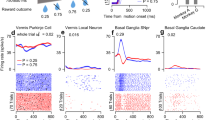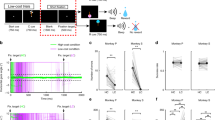Abstract
Action is controlled by both motivation and cognition. The basal ganglia may be the site where these kinds of information meet. Using a memory-guided saccade task with an asymmetric reward schedule, we show that visual and memory responses of caudate neurons are modulated by expectation of reward so profoundly that a neuron's preferred direction often changed with the change in the rewarded direction. The subsequent saccade to the target was earlier and faster for the rewarded direction. Our results indicate that the caudate contributes to the determination of oculomotor outputs by connecting motivational values (for example, expectation of reward) to visual information.
This is a preview of subscription content, access via your institution
Access options
Subscribe to this journal
Receive 12 print issues and online access
$209.00 per year
only $17.42 per issue
Buy this article
- Purchase on Springer Link
- Instant access to full article PDF
Prices may be subject to local taxes which are calculated during checkout







Similar content being viewed by others
References
Wurtz, R. H., Goldberg, M. E. & Robinson, D. L. Brain mechanisms of visual attention. Sci. Am. 246, 124–135 (1982).
Hillyard, S. A. Electrophysiology of human selective attention. Trends Neurosci. 8, 400–405 (1985).
Desimone, R. & Duncan, J. Neural mechanisms of selective visual attention. Annu. Rev. Neurosci. 18, 193–222 (1995).
Konorski, J. Integrative Activity of the Brain (Univ. Chicago Press, Chicago, 1967).
Mogenson, G. J., Jones, D. L. & Yim, C. Y. From motivation to action: functional interface between the limbic system and the motor system. Progress Neurobiol. 14, 69–97 (1980).
Watanabe, M. Reward expectancy in primate prefrontal neurons. Nature 382, 629–632 (1996).
Robbins, T. W. & Everitt, B. J. Neurobehavioural mechanisms of reward and motivation. Curr. Opin. Neurobiol. 6, 228–236 (1996).
Schultz, W., Apicella, P., Scarnati, E. & Ljungberg, T. Neuronal activity in monkey ventral striatum related to the expectation of reward. J. Neurosci. 12, 4595–4610 (1992).
Bowman, E. M., Aigner, T. G. & Richmond, B. J. Neural signals in the monkey ventral striatum related to motivation for juice and cocaine rewards. J. Neurophysiol. 75, 1061–1073 (1996).
Hikosaka, O., Sakamoto, M. & Usui, S. Functional properties of monkey caudate neurons. II. Visual and auditory responses. J. Neurophysiol. 61, 799–813 (1989).
Hikosaka, O., Sakamoto, M. & Usui, S. Functional properties of monkey caudate neurons. I. Activities related to saccadic eye movements. J. Neurophysiol. 61, 780–798 (1989).
Bushnell, M. C., Goldberg, M. E. & Robinson, D. L. Behavioral responses in monkey cerebral cortex. I. Modulation in posterior parietal cortex related to selective visual attention. J. Neurophysiol. 46, 755–772 (1981).
Ribak, C. E., Vaughn, J. E. & Roberts, E. The GABA neurons and their axon terminals in rat corpus striatum as demonstrated by GAD immunocytochemistry. J. Comp. Neurol. 187, 261–284 (1979).
Chevalier, G. & Deniau, J. M. Disinhibition as a basic process in the expression of striatal functions. Trends Neurosci. 13, 277–280 (1990).
Hikosaka, O. & Wurtz, R. H. in The Neurobiology of Saccadic Eye Movements (eds. Wurtz, R. H. & Goldberg, M. E.) 257–281 (Elsevier, Amsterdam, 1989).
Alexander, G. E. & Crutcher, M. D. Functional architecture of basal ganglia circuits: neural substrates of parallel processing. Trends Neurosci. 13, 266–271 (1990).
Preston, R. J., Bishop, G. A. & Kitai, S. T. Medium spiny neuron projection from the rat striatum: an intracellular horseradish peroxidase study. Brain Res. 183, 253–263 (1980).
Kawaguchi, Y., Wilson, C. J. & Emson, P. C. Projection subtypes of rat neostriatal matrix cells revealed by intracellular injection of biocytin. J. Neurosci. 10, 3421–3438 (1990).
Smith, A. D. & Bolam, J. P. The neural network of the basal ganglia as revealed by the study of synaptic connections of identified neurones. Trends Neurosci. 13, 259–265 (1990).
Groves, P. M., Linder, J. C. & Young, S. J. 5-Hydroxydopamine-labeled dopaminergic axons: Three dimensional reconstructions of axons, synapses and postsynaptic targets in rat neostriatum. Neuroscience 58, 593–604 (1994).
Schultz, W., Apicella, P. & Ljungberg, T. Responses of monkey dopamine neurons to reward and conditioned stimuli during successive steps of learning a delayed response task. J. Neurosci. 13, 900–913 (1993).
Schultz, W., Dayan, P. & Montague, P. R. A neural substrate of prediction and reward. Science 275, 1593–1599 (1997).
Parthasarathy, H. B., Schall, J. D. & Graybiel, A. M. Distributed but convergent ordering of corticostriatal projections: analysis of the frontal eye field and the supplementary eye field in the macaque monkey. J. Neurosci. 12, 4468–4488 (1992).
Houk, J. C., Adams, J. L. & Barto, A. G. in Models of Information Processing in the Basal Ganglia (eds. Houk, J. C., Davis, J. L. & Beiser, D. G.) 249–270 (MIT Press, Cambridge, Massachusetts, 1995).
Wickens, J. & Kötter, R. in Models of Information Processing in the Basal Ganglia (eds. Houk, J. C., Davis, J. L. & Beiser, D. G.) 187–214 (MIT Press, Cambridge, Massachusetts, 1995).
Gerfen, C. R. et al. D1 and D2 dopamine receptor-regulated gene expression of striatonigral and striatopallidal neurons. Science 250, 1429–1432 (1990).
Calabresi, P., De Murtas, M. & Bernardi, G. The neostriatum beyond the motor function: Experimental and clinical evidence. Neuroscience 78, 39–60 (1997).
Sawaguchi, T., Matsumura, M. & Kubota, K. Effects of dopamine antagonists on neuronal activity related to a delayed response task in monkey prefrontal cortex. J. Neurophysiol. 63, 1401–1412 (1990).
Williams, G. V. & Goldman-Rakic, P. S. Modulation of memory fields by dopamine D1 receptors in prefrontal cortex. Nature 376, 572–575 (1995).
Alexander, G. E., DeLong, M. R. & Strick, P. L. Parallel organization of functionally segregated circuits linking basal ganglia and cortex. Annu. Rev. Neurosci. 9, 357–381 (1986).
Hikosaka, O., Sakamoto, M. & Miyashita, N. Effects of caudate nucleus stimulation on substantia nigra cell activity in monkey. Exp. Brain Res. 95, 457–472 (1993).
Hikosaka, O. & Wurtz, R. H. Modification of saccadic eye movements by GABA-related substances. II. Effects of muscimol in the monkey substantia nigra pars reticulata. J. Neurophysiol. 53, 292–308 (1985).
Kato, M. & Hikosaka, O. in Age-Related Dopamine-Deficient Disorders (eds Segawa, M. & Nomura, Y.) 178–187 (Karger, Basal, 1995).
Matsumura, M., Kojima, J., Gardiner, T. W. & Hikosaka, O. Visual and oculomotor functions of monkey subthalamic nucleus. J. Neurophysiol. 67, 1615–1632 (1992).
Kato, M. et al. Eye movements in monkeys with local dopamine depletion in the caudate nucleus. I. Deficits in spontaneous saccades. J. Neurosci. 15, 912–927 (1995).
Kori, A. et al. Eye movements in monkeys with local dopamine depletion in the caudate nucleus. II. Deficits in voluntary saccades. J. Neurosci. 15, 928–941 (1995).
Miyashita, N., Hikosaka, O. & Kato, M. Visual hemineglect induced by unilateral striatal dopamine deficiency in monkeys. NeuroReport 6, 1257–1260 (1995).
Crawford, T. J., Henderson, L. & Kennard, C. Abnormalities of nonvisually-guided eye movements in Parkinson's disease. Brain 112, 1573–1586 (1989).
Hikosaka, O., Imai, H. & Segawa, M. in Vestibular and Brain Stem Control of Eye, Head and Body Movements (eds. Shimazu, H. & Shinoda, Y.) 405–414 (Japan Scientific Society Press, Tokyo, 1992).
Caplan, L. R. et al. Caudate infarcts. Arch. Neurol. 47, 133–143 (1990).
Bhatia, K. P. & Marsden, C. D. The behavioural and motor consequences of focal lesions of the basal ganglia in man. Brain 117, 859–876 (1994).
Hikosaka, O. in The Basal Ganglia IV: New Ideas and Data on Structure and Function (eds. Percheron, G., McKenzie, J. S. & Feger, J.) 589–596 (Plenum Press, New York, 1994).
Graybiel, A. M. Building action repertoires: memory and learning functions of the basal ganglia. Curr. Opin. Neurobiol. 5, 733–741 (1995).
Hikosaka, O. & Wurtz, R. H. Visual and oculomotor functions of monkey substantia nigra pars reticulata. III. Memory-contingent visual and saccade responses. J. Neurophysiol. 49, 1268–1284 (1983).
Aosaki, T. et al. Responses of tonically active neurons in the primate's striatum undergo systematic changes during behavioral sensorimotor conditioning. J. Neurosci. 14, 3969–3984 (1994).
Acknowledgements
We thank Masamichi Sakagami, Johan Lauwereyns, Katsuyuki Sakai, Hiroyuki Nakahara, Thomas Trappenberg and Brian Coe for comments, Makoto Kato for designing the computer programs and Masashi Koizumi for technical support. This work was supported by CREST (Core Research for Evolutional Science and Technology) of Japan Science and Technology Corporation (JST) and JSPS (Japan Society for the Promotion of Science) Research for the Future program.
Author information
Authors and Affiliations
Corresponding author
Rights and permissions
About this article
Cite this article
Kawagoe, R., Takikawa, Y. & Hikosaka, O. Expectation of reward modulates cognitive signals in the basal ganglia. Nat Neurosci 1, 411–416 (1998). https://doi.org/10.1038/1625
Received:
Accepted:
Issue Date:
DOI: https://doi.org/10.1038/1625
This article is cited by
-
Distinct value computations support rapid sequential decisions
Nature Communications (2023)
-
Nucleus accumbens D1-receptors regulate and focus transitions to reward-seeking action
Neuropsychopharmacology (2022)
-
Chemogenetic inactivation reveals the inhibitory control function of the prefronto-striatal pathway in the macaque brain
Communications Biology (2021)
-
Topographic distinction in long-term value signals between presumed dopamine neurons and presumed striatal projection neurons in behaving monkeys
Scientific Reports (2020)
-
Hypomania and saccadic changes in Parkinson’s disease: influence of D2 and D3 dopaminergic signalling
npj Parkinson's Disease (2020)



